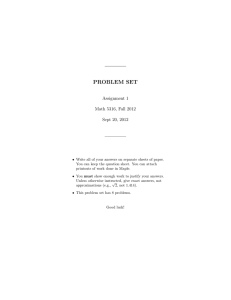Math 2250-1 Fri Sept 14
advertisement
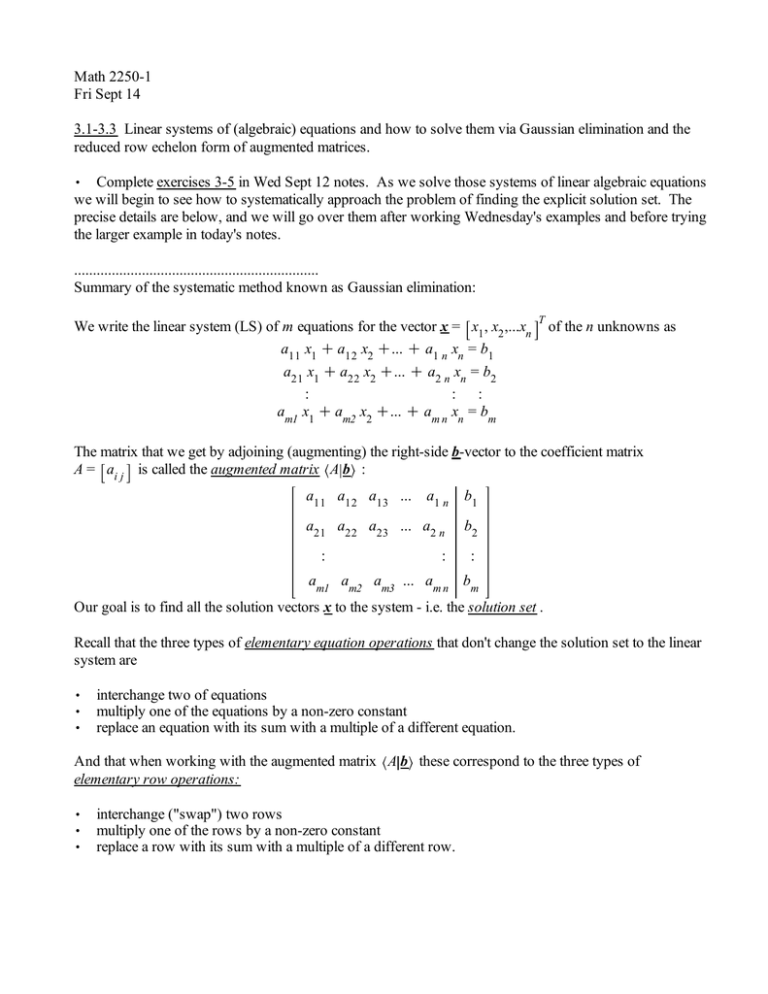
Math 2250-1 Fri Sept 14 3.1-3.3 Linear systems of (algebraic) equations and how to solve them via Gaussian elimination and the reduced row echelon form of augmented matrices. , Complete exercises 3-5 in Wed Sept 12 notes. As we solve those systems of linear algebraic equations we will begin to see how to systematically approach the problem of finding the explicit solution set. The precise details are below, and we will go over them after working Wednesday's examples and before trying the larger example in today's notes. ................................................................. Summary of the systematic method known as Gaussian elimination: We write the linear system (LS) of m equations for the vector x = x1 , x2 ,...xn a11 x1 C a12 x2 C... C a1 n xn = b1 a21 x1 C a22 x2 C... C a2 n xn = b2 : : : am1 x1 C am2 x2 C... C am n xn = bm T of the n unknowns as The matrix that we get by adjoining (augmenting) the right-side b-vector to the coefficient matrix A = ai j is called the augmented matrix A b : a11 a12 a13 ... a1 n b1 a21 a22 a23 ... a2 n b2 : : : am1 am2 am3 ... am n bm Our goal is to find all the solution vectors x to the system - i.e. the solution set . Recall that the three types of elementary equation operations that don't change the solution set to the linear system are , , , interchange two of equations multiply one of the equations by a non-zero constant replace an equation with its sum with a multiple of a different equation. And that when working with the augmented matrix A b these correspond to the three types of elementary row operations: , , , interchange ("swap") two rows multiply one of the rows by a non-zero constant replace a row with its sum with a multiple of a different row. Gaussian elimination: Use elementary row operations and work column by column (from left to right) and row by row (from top to bottom) to first get the augmented matrix for an equivalent system of equations which is in row-echelon form: (1) All "zero" rows (having all entries = 0) lie beneath the non-zero rows. (2) The leading (first) non-zero entry in each non-zero row lies strictly to the right of the one above it. (At this stage you could "backsolve" to find all solutions.) Next, continue but by working from bottom to top and from right to left instead, so that you end with an augmented matrix that is in reduced row echelon form: (1),(2), together with (3) Each leading non-zero row entry has value 1 . Such entries are called "leading 1's " (4) Each column that has (a row's) leading 1 has 0's in all the other entries. Finally, read off how to explicitly specify the solution set, by "backsolving" from the reduced row echelon form. Note: There are lots of row-echelon forms for a matrix, but only one reduced row-echelon form. All mathematical software will have a command to find the reduced row echelon form. Exercise 1 Find all solutions to the system of 3 linear equations in 5 unknowns x1 K 2 x2 C 3 x3 C 2 x4 C x5 = 10 2 x1 K 4 x2 C 8 x3 C 3 x4 C 10 x5 = 7 3 x1 K 6 x2 C 10 x3 C 6 x4 C 5 x5 = 27 . Here's the augmented matrix: 1 K2 3 2 1 10 2 K4 8 3 10 7 3 K6 10 6 5 27 Find the reduced row echelon form of this augmented matrix and then backsolve to explicitly parameterize the solution set. (Hint: it's a three-dimensional plane in =5 , if that helps. :-) ) Maple says: > with LinearAlgebra : # matrix and linear algebra library > A d Matrix 3, 5, 1,K2, 3, 2, 1, 2,K4, 8, 3, 10, 3,K6, 10, 6, 5 : b d Vector 10, 7, 27 : Ab ; # the mathematical augmented matrix doesn't actually have # a vertical line between the end of A and the start of b ReducedRowEchelonForm A b ; 1 K2 3 2 1 10 2 K4 8 3 10 7 3 K6 10 6 5 27 1 K2 0 0 3 5 0 0 1 0 2 K3 0 0 0 1 K4 7 > LinearSolve A, b ; # this command will actually write down the general solution, using # Maple's way of writing free parameters, which actually makes # some sense. Generally when there are free parameters involved, # there will be equivalent ways to express the solution that may # look different. But usually Maple's version will look like yours, # because it's using the same algorithm and choosing the free parameters # the same way too. > (1)


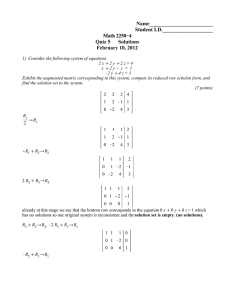

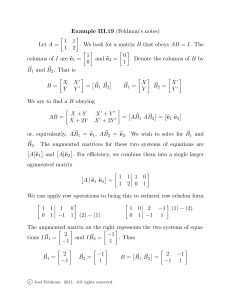
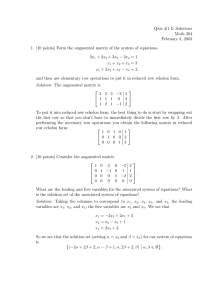
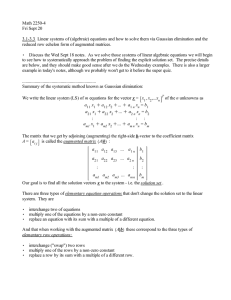
![Quiz #2 & Solutions Math 304 February 12, 2003 1. [10 points] Let](http://s2.studylib.net/store/data/010555391_1-eab6212264cdd44f54c9d1f524071fa5-300x300.png)

